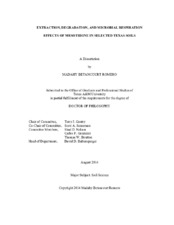| dc.description.abstract | The heavy use of pesticides in agriculture, have encouraged researchers to evaluate their behavior and potential environmental impacts of newer herbicides when applied alone or in combination with other herbicides. Mesotrione (2-[4-(methysulfonyl)-2-nitrobenzoyl]-1, 3-cyclohexanedione), a pre- and post-emergence herbicide is one of these newer herbicides used to control broadleaf weeds in corn. Assessing the soil behavior of newer herbicides is important to understand the potential impacts on key ecological processes. The primary objectives of this research were to: 1) determine the optimal conditions to extract mesotrione from four soils with varying physical and chemical characteristics using Accelerated Solvent Extraction (ASE); 2) study the effect of atrazine on mesotrione degradation in soil; and 3) determine if mesotrione, mesotrione + atrazine treatments, and application rates had an impact on soil microbial activity (respiration).
In the first experiment, mesotrione recoveries were not significantly different between two tested solvents across the four soils. The 4:1, acetonitrile: 5% acetic acid solvent was selected as the extraction solvent for all subsequent tests. When the three static cycles (1, 2, and 3) were evaluated, mesotrione recoveries were not significantly different between the three static cycles across the four soils. The two static cycles was selected as optimal, resulting in higher recoveries for the four soils. The investigation of extraction temperatures (50°C, 100°C, and 150°C) resulted in no significant differences between temperatures of 50°C and 100°C, and the temperature of 50°C was selected since higher recoveries obtained with that temperature. In the second experiment, the results demonstrated that mesotrione + atrazine herbicide mixtures have the potential to decrease mesotrione degradation in soils. However, it remained unclear whether the reduced degradation was due to the combined impacts of the herbicides, varying soil characteristics, and/or the soil microbial populations present in each soil. The third experiment resulted in the mesotrione and mesotrione + atrazine treatments that inhibited microbial activity (respiration) only at certain incubation time periods and rates for some soils. Furthermore, the mesotrione treatment was found to also stimulate microbial respiration at the 10X rate in the Orelia soil. Although rates effects on microbial respiration occurred, a trend was not observed in this study. | en |


